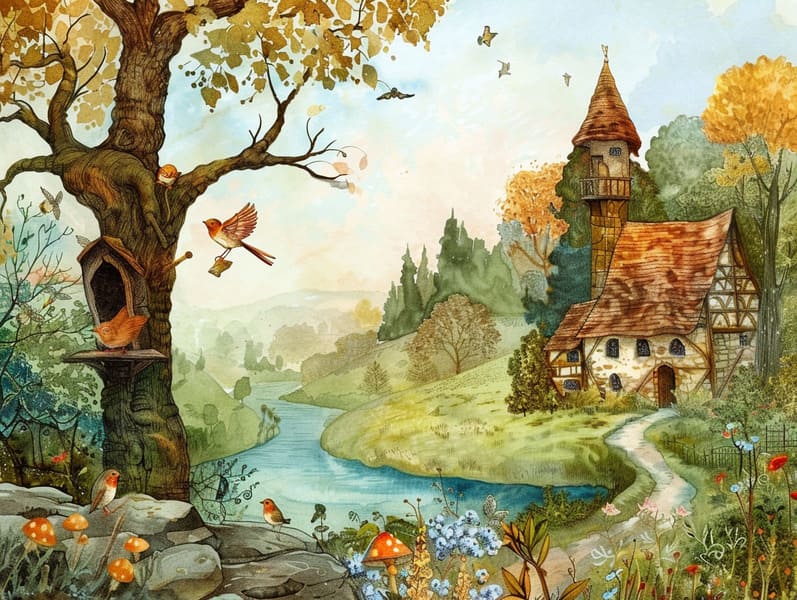Uncovering the Past of Fairy Tales for Kids with Its Continued Splendor.
Uncovering the Past of Fairy Tales for Kids with Its Continued Splendor.
Blog Article

Ancient fairy tales have timeless appeal. These narratives have been narrated from one generation to the next centuries before they were ever written down. They were born from a variety of backgrounds, including Asian traditions. They were initially transmitted among mature audiences, often carrying themes and messages pertaining to the societal norms and beliefs of the time.
The renowned Brothers Grimm, Jacob and Wilhelm Grimm, were among the first to gather and publish many of these beloved fairy tales. Their anthology, "Grimm's Children's Stories," included narratives like "Ashenputtel," "The Bread Crumb Trail," and "Little Snow White," which have since become hallmarks in the world of iconic fairy tales. Similarly, Hans Christian Andersen's enchanting stories, such as "The Story of the Little Mermaid," and "The Duckling's Story," have gained the love worldwide, ensuring their place in the pantheon of classic fairy tales.
Though they are centuries old, traditional fairy tales remain as important as ever, especially as children's bedtime stories. These delightful tales are now available in various formats, including vividly illustrated books, charming animations, and web-based fairy tales.
Their enduring popularity can be attributed to several fascinating points:
Key Lessons: Old fairy tales often offer important moral lessons. Fairy tales like "The Shepherd Boy and the Wolf" teach the merit of integrity, while "The Tale of the Tortoise and the Hare" demonstrate the virtues of steadfastness and humbleness. These stories offer little ones clear distinctions between moral and immoral, building their moral compass in a mild yet significant way.
Sympathy and Perception: Old fairy tales frequently showcase characters facing challenges and struggles, urging children to feel with their struggles and boost their triumphs. For instance, "Beauty's Beast" teaches us the virtue of seeing beyond looks to perceive the inner spirit of a character, enhancing kindness and understanding.
Cultural Insights: Many traditional fairy tales are imbued with the cultural contexts from which they originated. Discovering these narratives can provide illuminating insights into different beliefs, developing a sense of cultural appreciation and discernment.
Fantasy and Innovation: The magical elements in timeless fairy tales—magical spells—revitalize children’s fantasy worlds. These tales guide readers to otherworldly realms, inspiring inventive ideas and a sense of excitement that remains a lifetime.
Classic fairy tales are not only captivating but also informative. They provide captivating tools in developing various thinking and feeling skills in the young. When old fairy tales are narrated, they improve speech development by teaching new lexicon and detailed click here sentence structures. This practice also develops listening abilities and concentration, as the young pay close attention, looking forward to see what happens next.
Furthermore, exploring the themes and characters of ancient fairy tales can sharpen critical thinking and evaluative skills. Children are instructed to spot patterns, forecast, and get cause and effect. These analyses also encourage children say their thoughts and feelings, boosting their emotional intelligence.
In today’s modern era, the accessibility of online storybooks has made these stories more within reach than ever. Internet sites and apps offer wide arrays of traditional fairy tales that can be viewed or listened via anytime, anywhere. Fairy tales read out loud are particularly well-received, supplying an entertaining method for kids to relish these fantastical tales. Read-aloud books and spoken videos bring characters and settings to life, often complemented by mesmerizing harmonies and soundtracks that heighten the narrative experience.
The unending appeal of ancient fairy tales lies in their ability to change to the present while staying true to their core values. Contemporary renditions of these fairy tales often show more different protagonists and modern settings, making them pertinent to today’s audience. However, the underlying themes of fearlessness, empathy, and even-handedness remain unchanged, continuing to touch young listeners of all ages.
Classic fairy tales also offer a sense of coziness and recognition. They furnish a well-ordered narrative with a distinct beginning, middle, and end, often concluding with the settlement of conflicts and the triumph of righteousness over wickedness. This uniformity can be heartening for little ones, imparting a sense of sturdiness in an inconstant world.
Old fairy tales continue to captivate and coach new generations, maintaining their mystique and significance in modern society. As bedtime stories for kids, they deliver a perfect blend of delight and instruction, supporting moral values, empathy, and creativity. The proliferation of online fairy tales and the popularity of fairy tales voiced ratify that these classic tales remain accessible to new generations.
By holding onto and relating these tales, we continue to cherish the rich tapestry of myths and cultural heritage. Whether you are discovering a vividly illustrated book, perusing a virtual library, or listening to an audio story, the captivation of Grimm's fairy tales is always within reach. These fairy tales point out of the everlasting force of tales and its ability to unify us across centuries and lands.
No matter if you are discovering a colorful picture book, seeing a digital library, or hearing an narrated book, the allure of classic fairy tales is always within reach.
These fairy tales emphasize of the persistent power of fairy tales and its ability to join us across centuries and lands, weaving a spell that charms and informs alike.